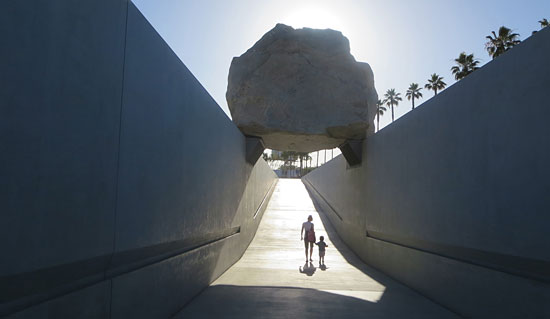This film could rock your world
August 13, 2014
Some movies launch with advertisements screaming from broadcasts, buses and billboards.
“Levitated Mass”— a documentary about the amazing journey of a 340-ton boulder into the hearts, minds and artistic consciousness of Southern California—is not one of those movies.
Although it tells a big, sprawling story about culture, community, bureaucratic challenges and engineering ingenuity, the documentary is going for more of a micro-targeted approach when it comes to publicizing its upcoming theatrical release.
As in: taking to the streets and putting up posters at points along the 105-mile-long “rock route” where large crowds gathered as the boulder slowly made its way to the Los Angeles County Museum of Art in March, 2012.
By heading out to those neighborhoods with bright yellow posters reading “Remember when the rock rolled?” director Doug Pray is hoping to reunite some of the diverse characters who witnessed its epic journey from a Riverside County quarry to LACMA, where it now forms part of a monumental sculpture that has been visited by more than 600,000 people. (When the sculpture first was unveiled, 6,000 visitors flocked to the museum, setting an opening-day attendance record. It also sparked voluminous coverage, including this video on Supervisor Yaroslavsky’s website.)
Pray’s documentary, which premiered at the L.A. Film Festival last year, begins its theatrical release on Sept. 5 with a one-week run at the Nuart Theatre before moving on to play a number of other cities this fall. The documentary is one part art film focusing on the work of sculptor Michael Heizer, one part road movie, and one part behind-the-scenes docudrama about how the rock rolled (and almost didn’t.)
Some of its best moments come in interviews with people from all walks of life who weigh in on what to make of the new behemoth on the block. (The movie trailer offers a taste of their critiques.)
One woman theorizes that the massive white-wrapped object is not really a boulder at all but rather a suspicious giant artifact left over from a secret military base.
Some of those lining the streets see a colossal waste of money (though the $10 million project was privately financed) while others experience genius at work. Some detect the hand of God, and others glimpse a parable for all of life’s journeys.
Throughout, the film captures the sense of a slo-mo happening-in-progress that people across the Southland felt free to experience—sometimes right in their own front yards.
As one young girl put it: “Nothing really happens on this street, and now something amazing just happened.”
Beyond its chronicle of those who watched the rock roll through three counties and 22 diverse communities over the course of 10 days and nights, the film also offers some unusual inside footage: computer simulations of how the boulder would fare in an earthquake, artist Heizer interacting with workers installing the massive stone atop a concrete trench at LACMA, interviews with art world elites and donors, government officials grappling with seemingly impossible logistics, and some reality TV-style moments showing what happens when a transport truck’s transmission suddenly seizes up mid-voyage. (Spoiler alert: they figure out a way to get to a happy ending.)
Then there’s the boulder itself, which filmmaker Pray is only a little sheepish about dubbing a “rock star.”
“It’s as close as I’ve ever come to making an inanimate object into a character,” Pray said. “Because it kind of grows on you. It does have personality…It definitely became its own pop culture phenomenon. The whole joke of ‘the rock became a star,’ it’s a silly pun but the truth is it literally did.”
And, as big as the rock is, the film makes clear that it also fostered something even larger: a sense of community across our sprawling Southern California landscape.
“From wealthy neighborhoods to poor neighborhoods, from Riverside to Long Beach to downtown L.A.,” Pray said, “it was like the boulder itself kind of made this into a portrait of L.A.”
Posted 8/13/14

















 405 bridge work causes a stink
405 bridge work causes a stink